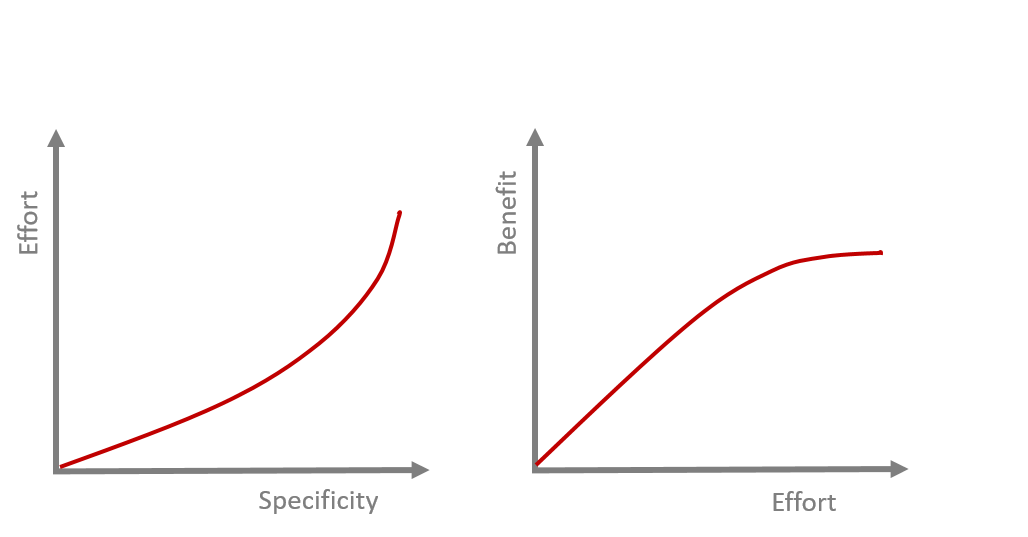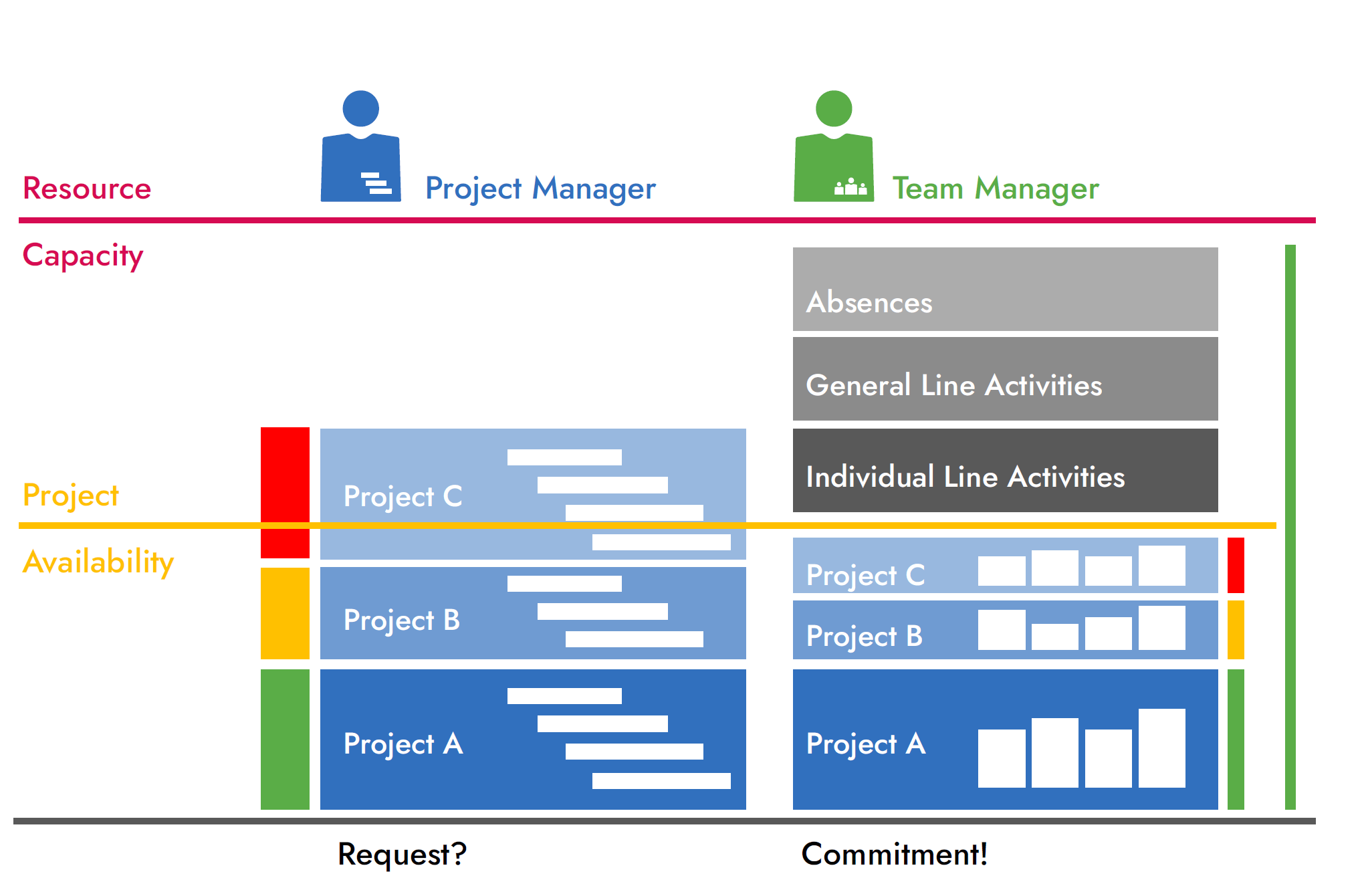This article concerns the specificity and completeness of tactical resource planning. You learn which role these two aspects play. This will help you accomplish truly valid planning.
Please note: By tactical resource planning, we mean the coordination between project and line managers. This depends on the company’s form of organization (matrix or line). The goal is to meet the requirements for resources with the necessary skills for projects in a timely manner using staff from the line. This tends to be the team leaders’ task.
Below, you will learn about the following topics:
- What is specificity in resource planning
- What affects the specificity
- Completeness in resource planning
- Learning to live with imprecision in planning
- Getting the team leaders on board
- Conclusion
What Is Specificity in Resource Planning?
On the one hand, the specificity in resource planning concerns the level of detail of the planned activities. On the other hand, it is about the overall currency of the planning, i.e. how often it is updated.
The more detailed and frequent your planning, the more time-consuming it becomes.
If you adopt the approach that more specific planning is also better planning, you run a risk. You may be investing too much. What is more, you may not be able to sustain this planning effort over the long term.

Is it actually useful to know every day on an hourly basis what each resource is working on? Or is planning on a weekly (at project level) or monthly basis (for work packages) sufficient for you?
What is your optimum effort-benefit ratio in order to have sufficient information to make necessary decisions?
Specificity in planning always needs to serve sensible requirements. This the only way you can justify the effort.
Special Download: 3 Important Points for your Tactical Resource Planning (PDF file)
Please fill in the form.
* Required Fields | Data Protection
In a matrix organization, team leaders do not need to commit their resources to every individual task of the projects. It should be enough to know who is working on which project. And when. The projects managers are the ones who plan the details.
Conversely, project managers in a line organization do not need to know each task necessary for delivery. In this case, the team leaders are the ones who plan the details.
Accordingly, everyone plans that, for which he or she is responsible. Not twice, but there will be overlaps at the appropriate level. These overlaps will serve for comparison and coordination.
Our tip: Ask yourself: “Is it actually useful to know every day on an hourly basis what each resource is working on? Or is planning on a weekly or monthly basis sufficient for me at the level of projects or work packages respectively?”
What Affects the Specificity
The decision on the necessary and sustainable specificity of your resource planning is affected by the following factors, for example:
- Number of resources and projects
- Duration of the projects and their activities
- Efforts in the projects
- Complexity of the schedules
- Changing work sites
- Personal responsibility of the team members
- Frequency of interferences
In addition, what specificity makes sense depends on the types of projects in your portfolio. There are substantial differences between for example:
- Small-scale IT projects
- Development of vehicle components
- Development of pharmaceutical products
- Plant manufacturing
Ultimately, your task is this. Find a granularity for your resource planning, which is sustainable and proportionate to the benefits.
In our experience, you will succeed by the approximation from rough to fine. Presuppose complete planning. It is THE prerequisite for any benefit.
Our tip: Find a sustainable granularity for your resource planning, which is proportionate to the desired benefit. Go from the rough to the fine and ensure COMPLETE planning at all events!
Completeness in Resource Planning
As long as your resource planning rests on an incomplete basis of information, you will very likely not succeed. It must take all activities of the staff members into consideration. All activities, which do not appear in your planning, indicate an error in planning.
Planning errors due to misestimations will become smaller with increasing experience and care. Besides, such errors can usually be contained. And as a rule, stakeholders will be sympathetic about miscalculations from lack of experience. You can also indicate minimum, probable and maximum effort in estimations. This makes it possible to determine ranges.
Another interesting read: Resource Planning by Team Leaders – Processes & Methods
If, however, projects and activities do not appear in your planning, although they are carried out, you are dealing with inestimable planning errors. These are definitely worse. But you can, and should, avoid this kind of error at all costs. For other stakeholders will not be sympathetic about it.
Reasons for incompleteness in resource planning often are:
- Some project managers use resources in their projects without previously checking their availability. Or they are not using the right tool. As a result, the overall resource utilization does not become visible.
- Some team leaders will do all they can to make sure nobody gets an insight into their internal activities. If at all possible, they want to continue their undisturbed and quiet life on their little island. Thus, they undermine all efforts for transparency.
Free Download: eBook “Tactical Resource Management” (more than 80 pages)
Resource planning between project managers and team leaders is always a challenge in project management. In this free eBook, you will learn how meeting this challenge can become easier.
> Click here to download your free copy of the eBook.
If you make statements about availabilities of staff which are not based on complete information, you will run into difficulties sooner or later. These could be:
- Unpredictable resources conflicts
- Severe overload for preferred staff members
- Insufficient workload for some other resources
- Lack of profitability
Our tip: Make sure that team leaders record all activities of the resources on their teams without fail. Otherwise, you will not be able to avoid resource conflicts.
If you do not ensure this, the information on the availability of the team will be distorted. As a result, staff members with no remaining availability will be scheduled for projects. Hence, resource conflicts are inevitable.
Special Download: Resource Planning Software for the Roles Involved (PDF file)
Please fill in the form.
* Required Fields | Data Protection
Learning to Live with Imprecision in Planning
The premise in planning is always the same and accordingly:
Our tip: Better to be complete and slightly unspecific in planning than partly very specific and partly incomplete.
As ever, resource planning is subject to frequent changes due to the dynamic environment. Examples of this can be:
- Unexpected absence of an important team member
- Change requests
- Miscalculation of the effort
To optimize the effort and benefit of planning, the general rule is: accept that you must live with imprecision in planning.
When planning is too detailed, it is impossible to keep it up to date in the long run. It will lag behind reality soon. You cannot plan everything very specifically, as it takes too long and parts of planning will be superseded by reality. Therefore, you should be as rough as possible and as detailed as necessary in your planning.
Our tip: Live with imprecision in your planning. When planning is too detailed, it is out of date quickly and therefore ceases to be useful. Be as rough as possible and as detailed as necessary in your planning.
Thus, begin with complete planning. In the beginning, it should be updated only once a month. However, it should include all projects and activities.
There are good examples of planning projects only roughly at first. In such a case, you do not initially assign resources to tasks but to phases or even only to projects. At this stage, resources may not be individuals but teams, i.e. two developers rather than Miller and Meyer.
Once your planning runs smoothly at this level, you can begin to update it more frequently and plan in more detail.
Our tip: Small steps! Experience has shown that you should not overwhelm your organization at the beginning. This greatly reduces the risk of failure when introducing tactical resource planning.
Getting the Team Leaders on Board
At best, projects managers have knowledge of the workload of staff members from their project management tool. But this information is usually incomplete.
Hence, it is advisable to get the team leaders on board from the outset. They are the best informed about the workload of their teams at any rate. And they should be acquainted with all their team members’ project assignments and other activities.
You might also like our article Project Resource Management.
Ideally, team leaders plan from their own perspective and for their own benefit. This is to be regarded as complementary to the project planning by the project managers.
Both roles have their own planning but are using the same basis. The appropriate resource management tool enables a comparison between the two to determine the availability for projects. And here is how it works:
The team leaders specify the project availability of their team. It is calculated as follows (see figure below):
- Resource capacity
- minus absences (sick days, vacation or training)
- minus the general and individual operations
- equals project availability
The following figure represents the difference in the project availability as calculated by:
- Team leader (right)
- Requests from projects (left)
The result is different, so that Project B and C cannot be committed fully.

Depending on the form of organization, the team leaders can plan or commit the time available for projects:
- In the line organization, team leaders can plan the project availability for requested deliverables themselves.
- In the matrix organization, team leaders commit their team members to projects, which requested resources from them.
Conclusion – Specificity in Resource Planning
This article has introduced you to the roles of completeness and specificity in resource planning. You have learned that it is more important to be complete and slightly unspecific in your resource planning than very specific but incomplete.
You should also get used to living with imprecision in your planning. After all, too detailed planning may not be possible to sustain, is quickly outdated and in consequence no longer useful. Be as rough as possible and as detailed as necessary in your planning.
The team leaders must consider all activities of each resource on their team in the utilization. On this basis, they can determine the remaining project availability flawlessly. The team leaders’ role is particularly central to making tactical resource planning work.
Do you agree with our view of the role of specificity in resource planning? Is there anything you would like to add? We look forward to reading your comments below.
About the author: Johann Strasser, a certified engineer, has been a managing partner at TPG The Project Group since 2001. After many years as a development engineer in the automotive and energy sectors, Johann Strasser spent a decade as an independent trainer and consultant in the field of project management. During his tenure, he also served as project manager for software projects in the construction industry and provided scheduling and cost management support for large-scale construction projects. At TPG, he applies his expertise in product development and consulting services for international clients. His special focus is on PMO, project portfolios, hybrid project management, and resource management. For many years now, he has shared his knowledge through presentations, seminars, articles, and webinars.
You can read more about Johann Strasser on LinkedIn and XING.






